Cluster and Redundancy Analyses of Taiwan Upstream Watersheds Based on Monthly 30 Years AVHRR NDVI3g Data
Abstract
:1. Introduction
2. Materials and Methods
2.1. Study Area
2.2. Research Procedure
2.3. Data Acquisition
2.3.1. Normalized Difference Vegetation Index
2.3.2. Temperature and Rainfall
2.3.3. Slope and Aspect
2.3.4. Potential Debris Streams and Affected Area
2.3.5. Climate Change Scenarios
2.4. Statistics Models
2.4.1. Hierarchical Cluster Analysis
2.4.2. Redundancy Analysis
- For the arrows, the pointed direction represents the maximum increase in the variable’s value across the diagram, and its length is proportional to the maximum rate of change.
- Project the case points perpendicular to the RV or EV arrow to obtain an approximate ordering of the value of one RV or EV across cases.
- Predict a case point projecting onto the origin of the coordinate system (perpendicular to an RV or EV arrow) to gain an average value of the corresponding variable. To obtain above and below-average values, the cases projecting further from zero in the direction of the arrow and opposite direction are predicted, respectively.
- The relative directions of arrows approximate the linear correlation coefficients among the variables. In other words, the value of an RV can be predicted to have a positive correlation with an EV value if that EV arrow points in an analogous direction to an RV arrow.
- The individual relationship of any two arrows is indicated by the cosine of the angles between the arrows. Any two variables will be predicted to have a weak correlation if the arrows intersect at a right angle (near to zero).
3. Results
3.1. Time Series Data for NDVI, Rainfall, Temperature for Upstream Watershed
3.2. Cluster Analysis for Upstream Watershed NDVI
3.3. Identifying Important Driving Factors
3.4. Climate Change Scenarios for Each Cluster
3.4.1. Rainfall Change Rate for Each Cluster
3.4.2. Temperature Change for Each Cluster
3.4.3. Temporal Variation of Rain Change Rate and Temperature Data
3.5. Potential Debris Streams and Affected Areas
4. Discussion
5. Conclusions
Author Contributions
Funding
Institutional Review Board Statement
Informed Consent Statement
Data Availability Statement
Conflicts of Interest
Appendix A
| # | Serial Number of Watershed | City/County | Name of River Basin | Name of Watershed | Area of Watershed (km2) |
|---|---|---|---|---|---|
| 1 | 1002 | Taichung City | Dajia River | Guguan adjustment pool | 196.12 |
| 2 | 1204 | Nantou County | Zhuoshui River | Shuili river | 58.03 |
| 3 | 1504 | Chiayi County | Bazhang River | Luliao reservoir | 8.48 |
| 4 | 1704 | Tainan County | Zengwen River | Jingmian reservoir | 16.24 |
| 5 | 2505 | Hualien County | Xiuguluan River | Xiuguluan river | 200.54 |
| 6 | 2607 | Hualien County | Hualien River | Ji-an river | 35.02 |
| 7 | 0101 | Yilan County | Lanyang River | Lanyang river | 932.65 |
| 8 | 0102 | Yilan County | Lanyang River | Yilan river | 187.72 |
| 9 | 0401 | Hsinchu County | Tamsui River | Shimen reservoir | 835.90 |
| 10 | 0402 | New Taipei City | Tamsui River | Feitsui reservoir | 328.80 |
| 11 | 0403 | Taoyuan City | Tamsui River | Dahan river | 451.85 |
| 12 | 0404 | New Taipei City | Tamsui River | Hsindian river | 541.30 |
| 13 | 0501 | Hsinchu County | Fengshan River | Fengshan river | 277.73 |
| 14 | 0601 | Hsinchu County | Touchian River | Touchian river | 626.72 |
| 15 | 0701 | Miaoli County | Zhonggang River | Zhonggang river | 375.61 |
| 16 | 0702 | Hsinchu County | Zhonggang River | Dapu reservoir | 121.51 |
| 17 | 0801 | Miaoli County | Houlong River | Houlong river | 526.84 |
| 18 | 0802 | Miaoli County | Houlong River | Mingde reservoir | 88.74 |
| 19 | 0901 | Miaoli County | Daan River | Daan river | 765.56 |
| 20 | 0902 | Miaoli County | Daan River | Liyutan reservoir | 81.97 |
| 21 | 1001 | Taichung City | Dajia River | Deji reservoir | 574.86 |
| 22 | 1003 | Taichung City | Dajia River | Tianlun adjustment pool | 93.30 |
| 23 | 1004 | Taichung City | Dajia River | Shigang reservoir | 344.74 |
| 24 | 1005 | Taichung City | Dajia River | Dajia river | 163.71 |
| 25 | 1101 | Taichung City | Wu River | Beigang river | 565.48 |
| 26 | 1102 | Nantou County | Wu River | Nangang river | 473.49 |
| 27 | 1104 | Taichung City | Wu River | Dali river | 433.64 |
| 28 | 1105 | Changhua County | Wu River | Maoluo river | 407.12 |
| 29 | 1106 | Changhua County | Wu River | Wu river | 229.14 |
| 30 | 1201 | Nantou County | Zhuoshui River | Wushe reservoir | 245.89 |
| 31 | 1202 | Nantou County | Zhuoshui River | Wujie adjustment pool | 368.04 |
| 32 | 1203 | Nantou County | Zhuoshui River | Sun Moon Lake reservoir | 33.75 |
| 33 | 1205 | Yunlin County | Zhuoshui River | Zhuoshui river | 771.10 |
| 34 | 1206 | Nantou County | Zhuoshui River | Danda river | 294.12 |
| 35 | 1207 | Nantou County | Zhuoshui River | Junda river | 455.64 |
| 36 | 1208 | Nantou County | Zhuoshui River | Chenyoulan river | 490.91 |
| 37 | 1209 | Chiayi County | Zhuoshui River | Qingshui river | 462.69 |
| 38 | 1210 | Nantou County | Zhuoshui River | Kashe river | 183.99 |
| 39 | 1211 | Nantou County | Zhuoshui River | Dongpuna river | 109.24 |
| 40 | 1301 | Yunlin County | Beigang River | Huwei river | 332.03 |
| 41 | 1302 | Yunlin County | Beigang River | Sandie river | 209.73 |
| 42 | 1501 | Chiayi County | Bazhang River | Bazhang river | 460.98 |
| 43 | 1601 | Chiayi County | Jishui river | Baihe reservoir | 38.69 |
| 44 | 1701 | Kaoshiung City | Zengwen River | Zengwen reservoir | 519.83 |
| 45 | 1702 | Tainan City | Zengwen River | Wushantou reservoir | 70.29 |
| 46 | 1703 | Tainan City | Zengwen River | Nanhua reservoir | 138.94 |
| 47 | 1705 | Tainan City | Zengwen River | Zengwen river | 624.05 |
| 48 | 2101 | Kaoshiung City | Kaoping River | Qishan river | 819.68 |
| 49 | 2102 | Kaoshiung City | Kaoping River | Laonong river | 1537.71 |
| 50 | 2103 | Pingtung County | Kaoping River | Ailiao river | 678.61 |
| 51 | 2401 | Taitung County | Beinan River | Beinan river | 1017.08 |
| 52 | 2402 | Taitung County | Beinan River | Hsinwulue river | 733.84 |
| 53 | 2501 | Hualien County | Hsiuguluan River | Hsiuguluan river | 765.36 |
| 54 | 2502 | Hualien County | Hsiuguluan River | Hsiuguluan river | 190.30 |
| 55 | 2503 | Hualien County | Hsiuguluan River | Hsiuguluan river | 494.19 |
| 56 | 2504 | Hualien County | Hsiuguluan River | Hsiuguluan river | 313.83 |
| 57 | 2601 | Hualien County | Hualien River | Hualien river coastal area | 503.83 |
| 58 | 2602 | Hualien County | Hualien River | Maan river | 173.83 |
| 59 | 2603 | Hualien County | Hualien River | Wanli river | 267.11 |
| 60 | 2604 | Hualien County | Hualien River | Shoufeng river | 236.08 |
| 61 | 2605 | Hualien County | Hualien River | Mugua river | 486.47 |
| 62 | 2606 | Hualien County | Hualien River | Meilun river | 101.20 |
| 63 | 2701 | Hualien County | Heping River | Heping river | 629.64 |
| 64 | 2703 | Yilan County | Heping River | Nanao river | 361.65 |
| 65 | 4301 | Taitung County | River system of Taitung coastal area | Taiping river | 120.61 |
| 66 | 4302 | Taitung County | River system of Taitung coastal area | Lichia river | 194.73 |
| 67 | 4403 | Taitung County | Rivers on the east side of the Coastal Mountains | Mawu river | 163.43 |
| 68 | 4601 | Hualien County | River system of Taroko coastal area | Kanaan coastal area | 98.88 |
| 69 | 4602 | Hualien County | River system of Taroko coastal area | Liwu river | 693.63 |
| 70 | 4603 | Hualien County | River system of Taroko coastal area | Shanzhan river | 149.79 |
Appendix B
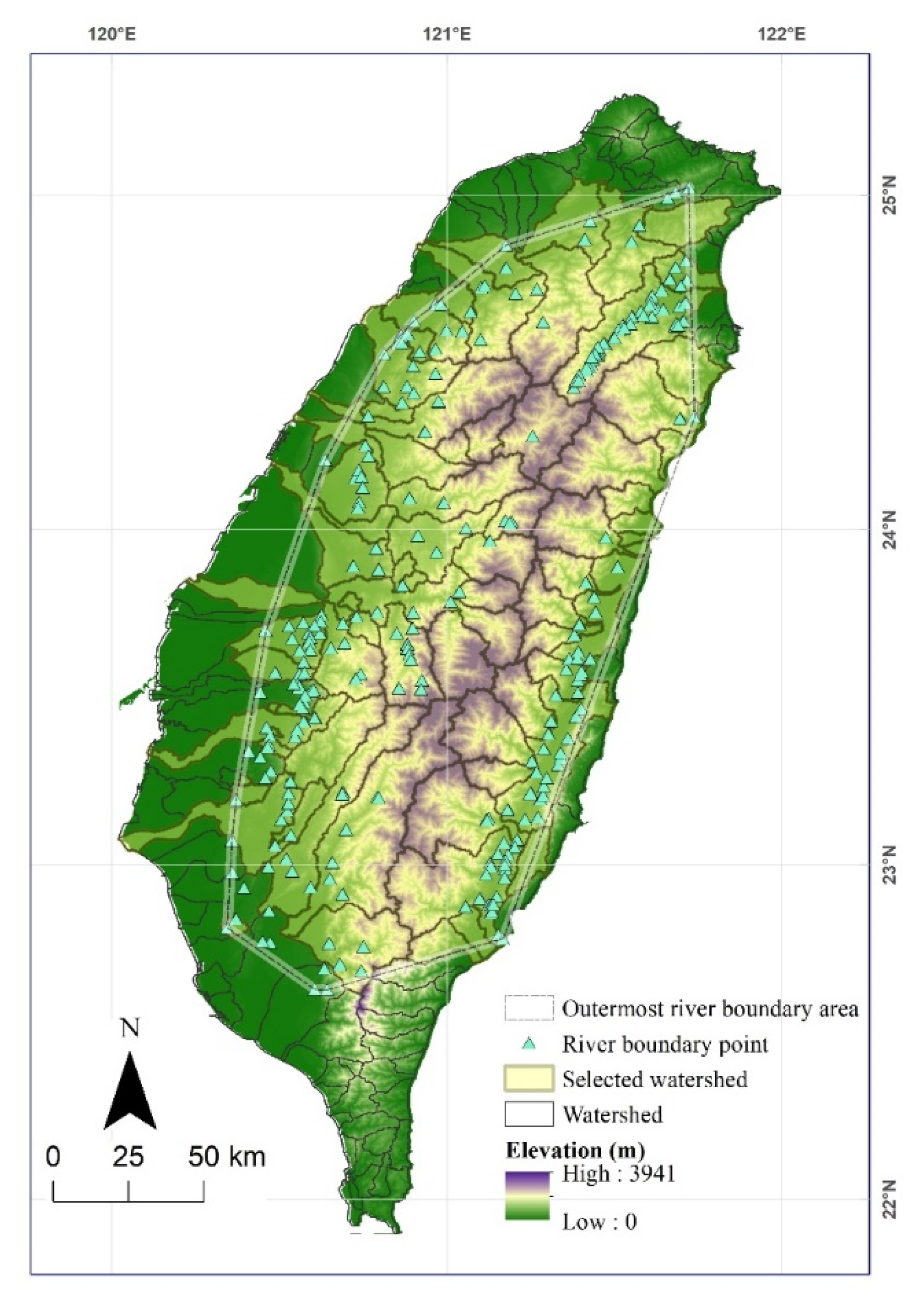
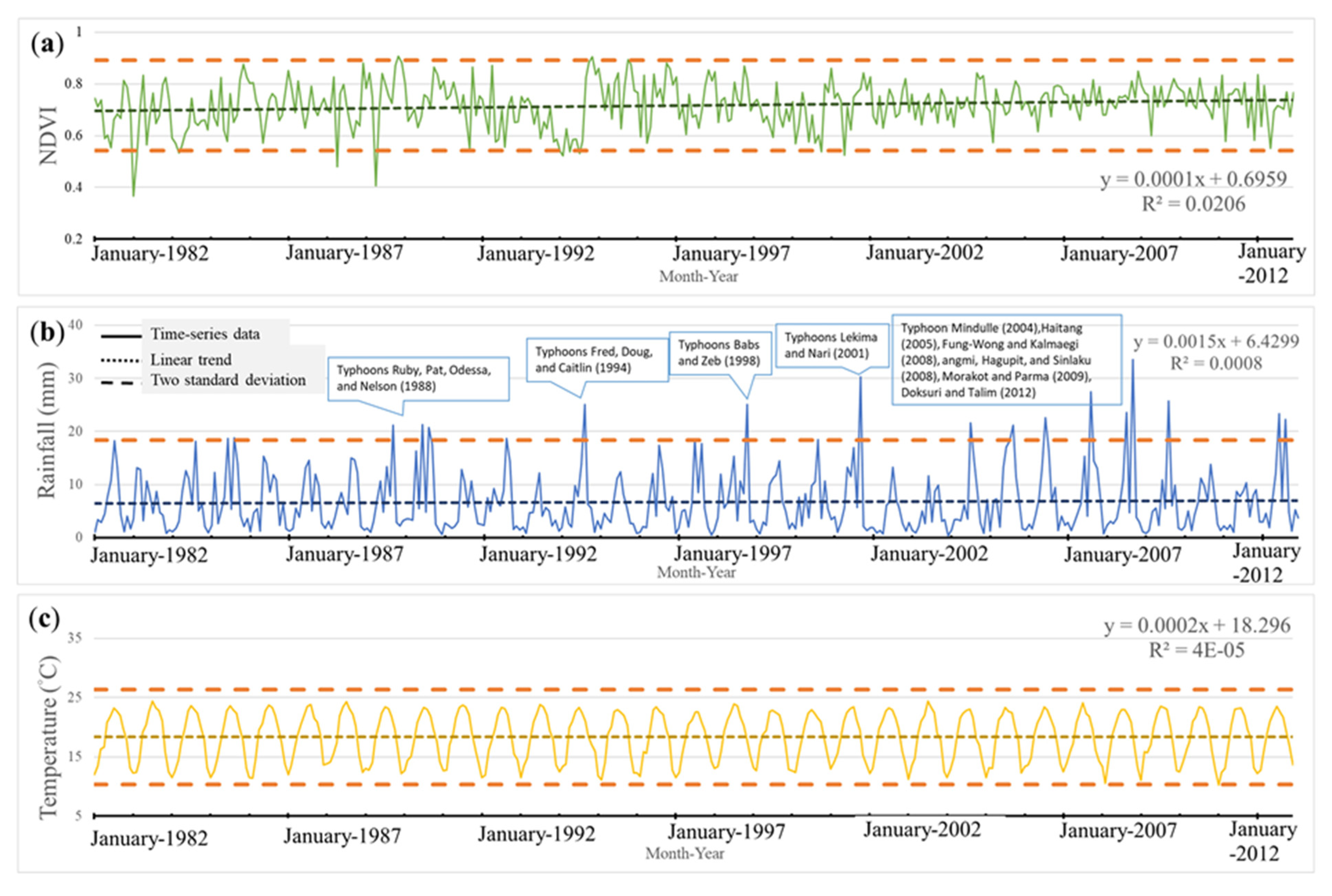
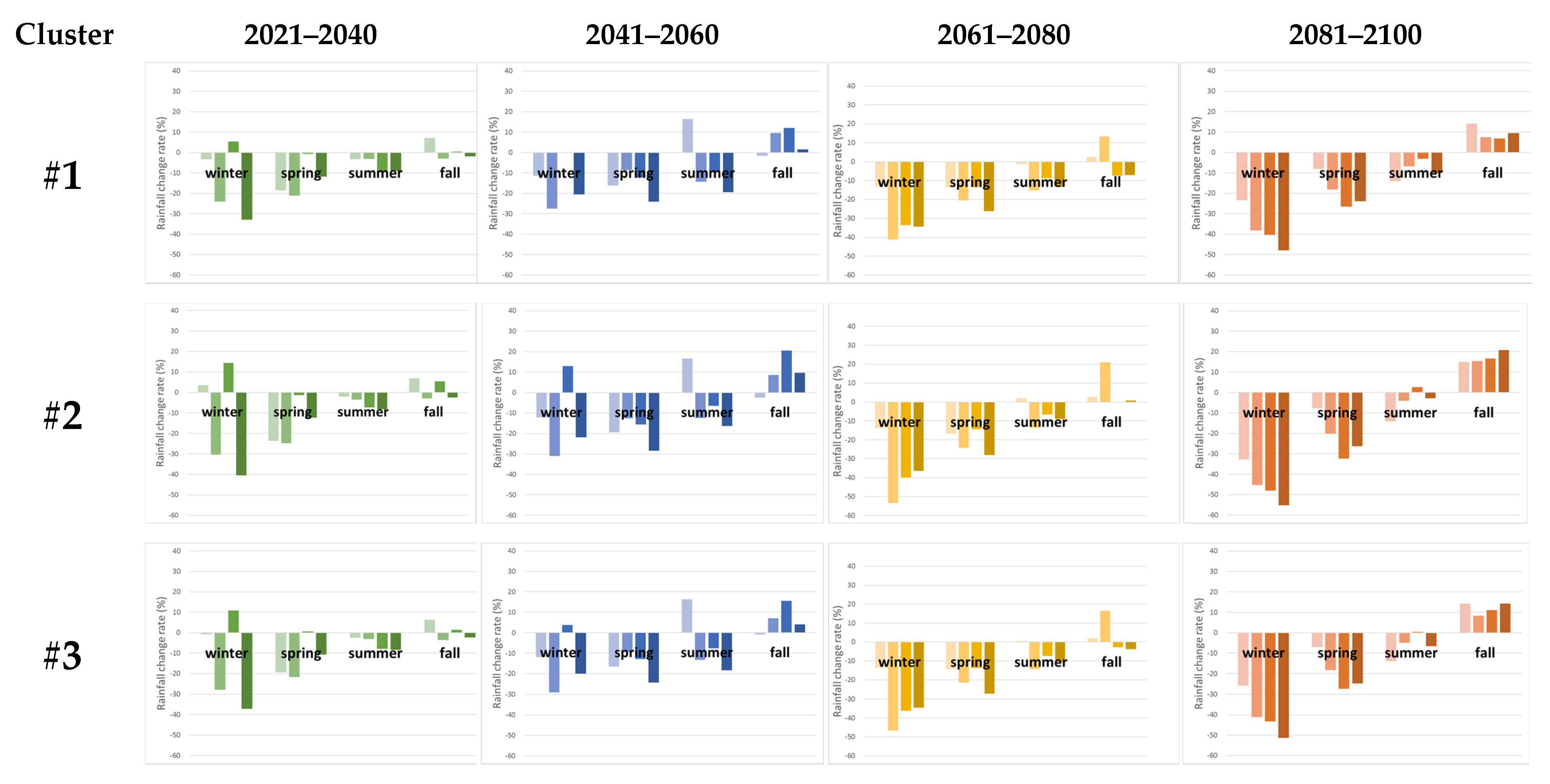
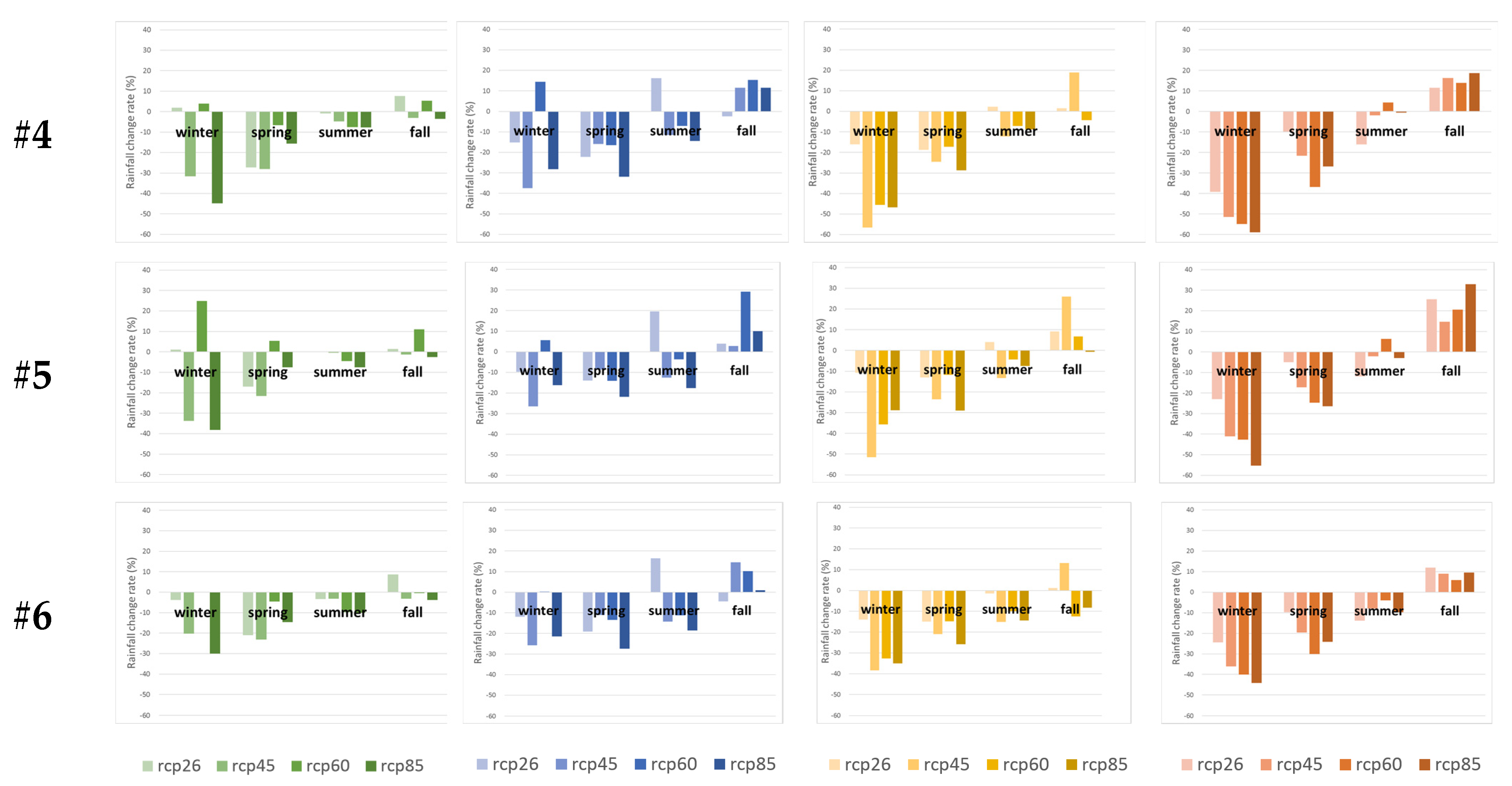
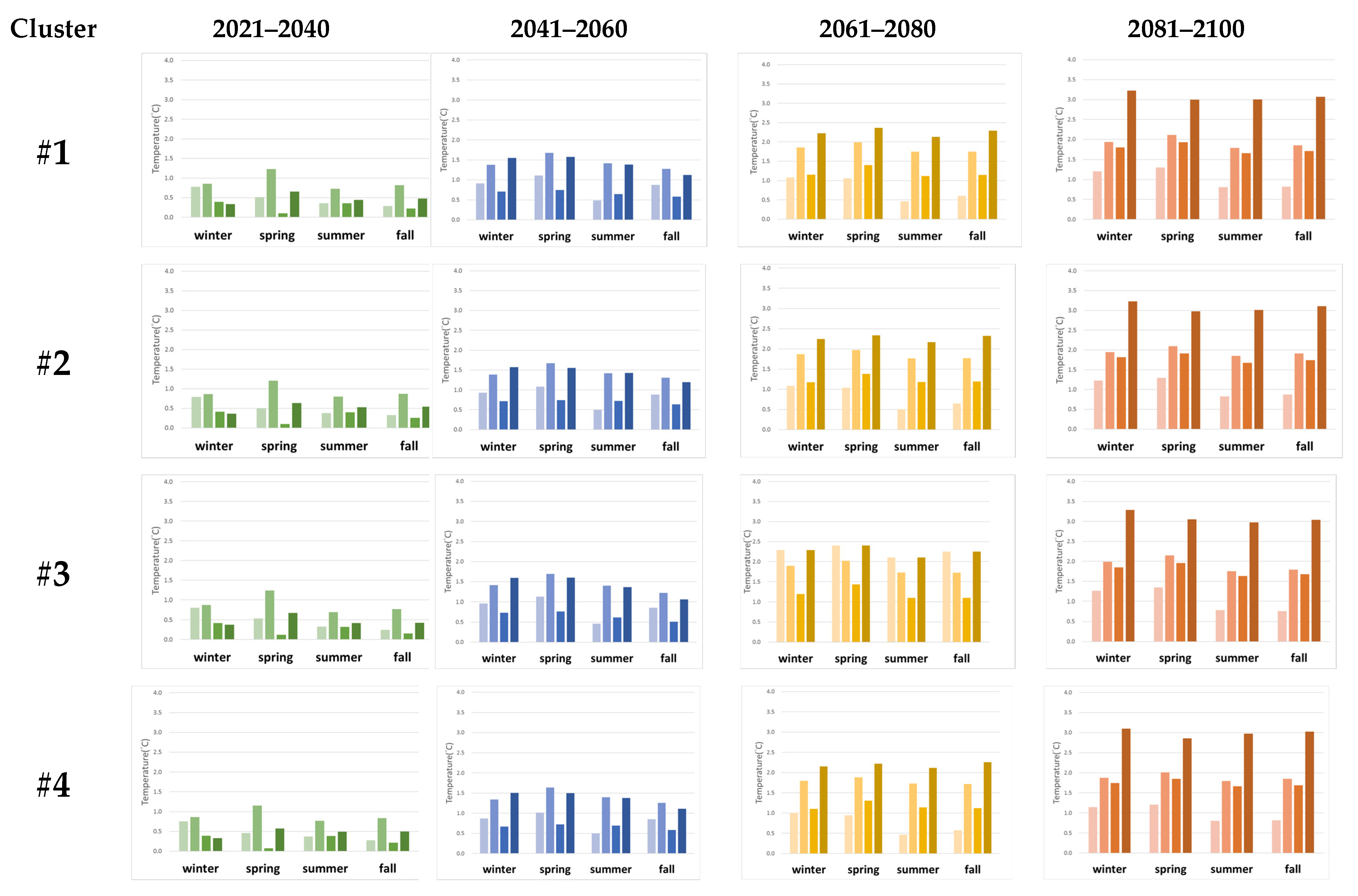
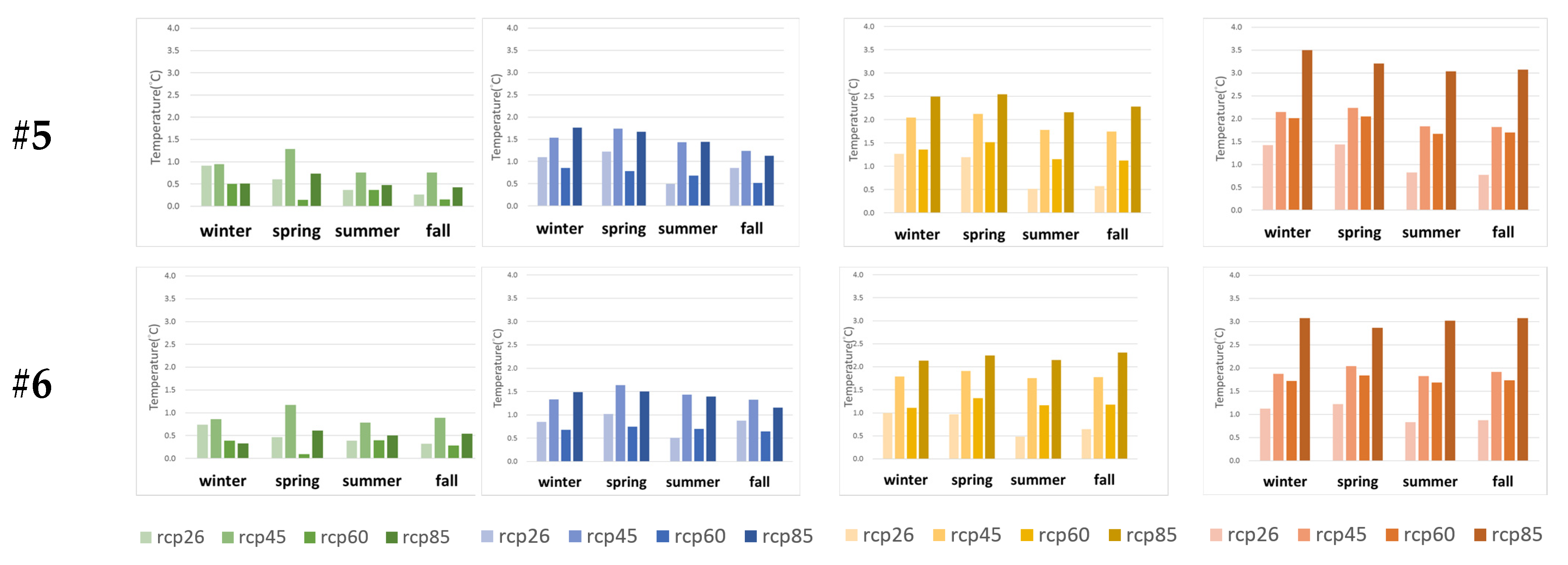
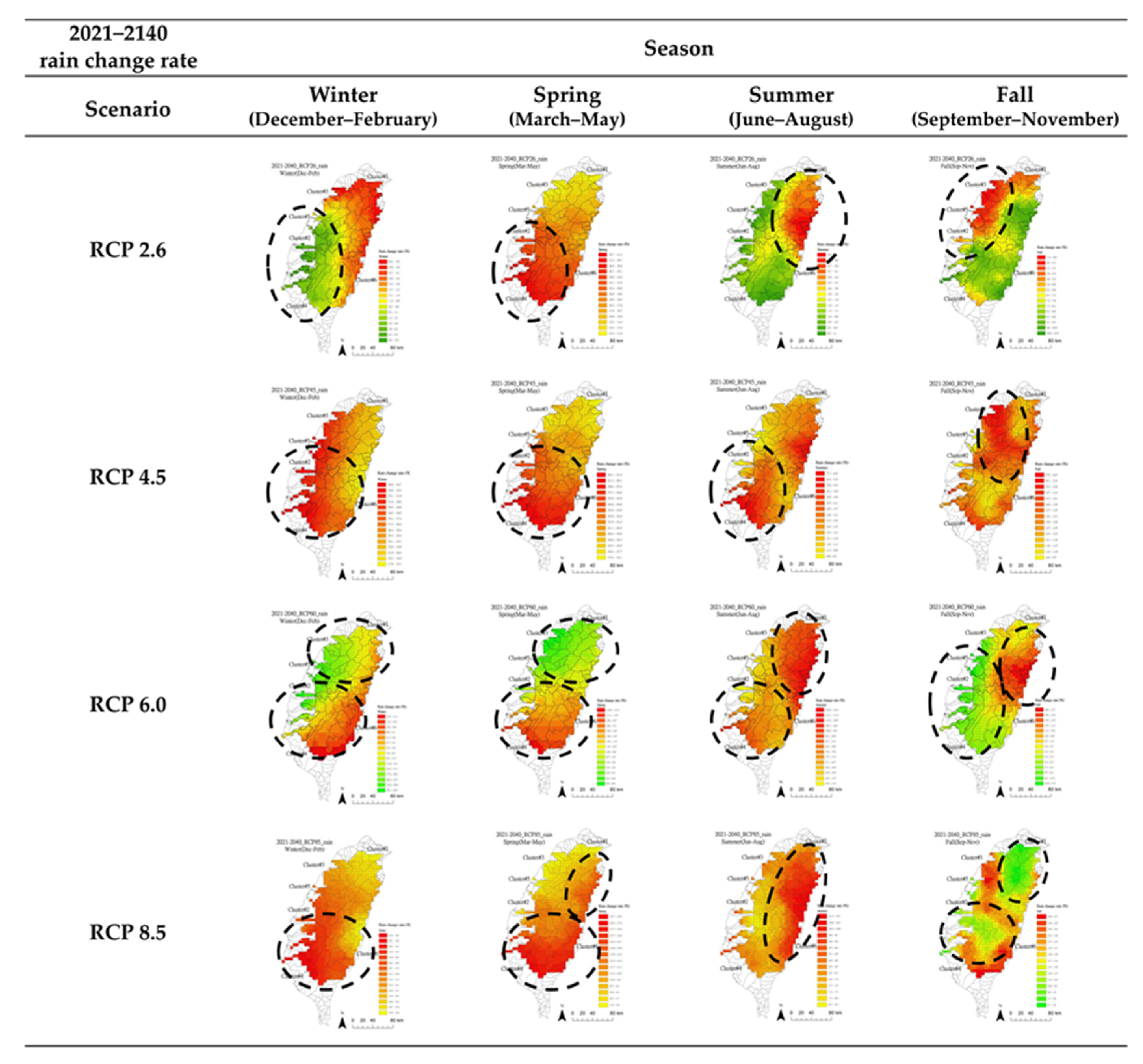
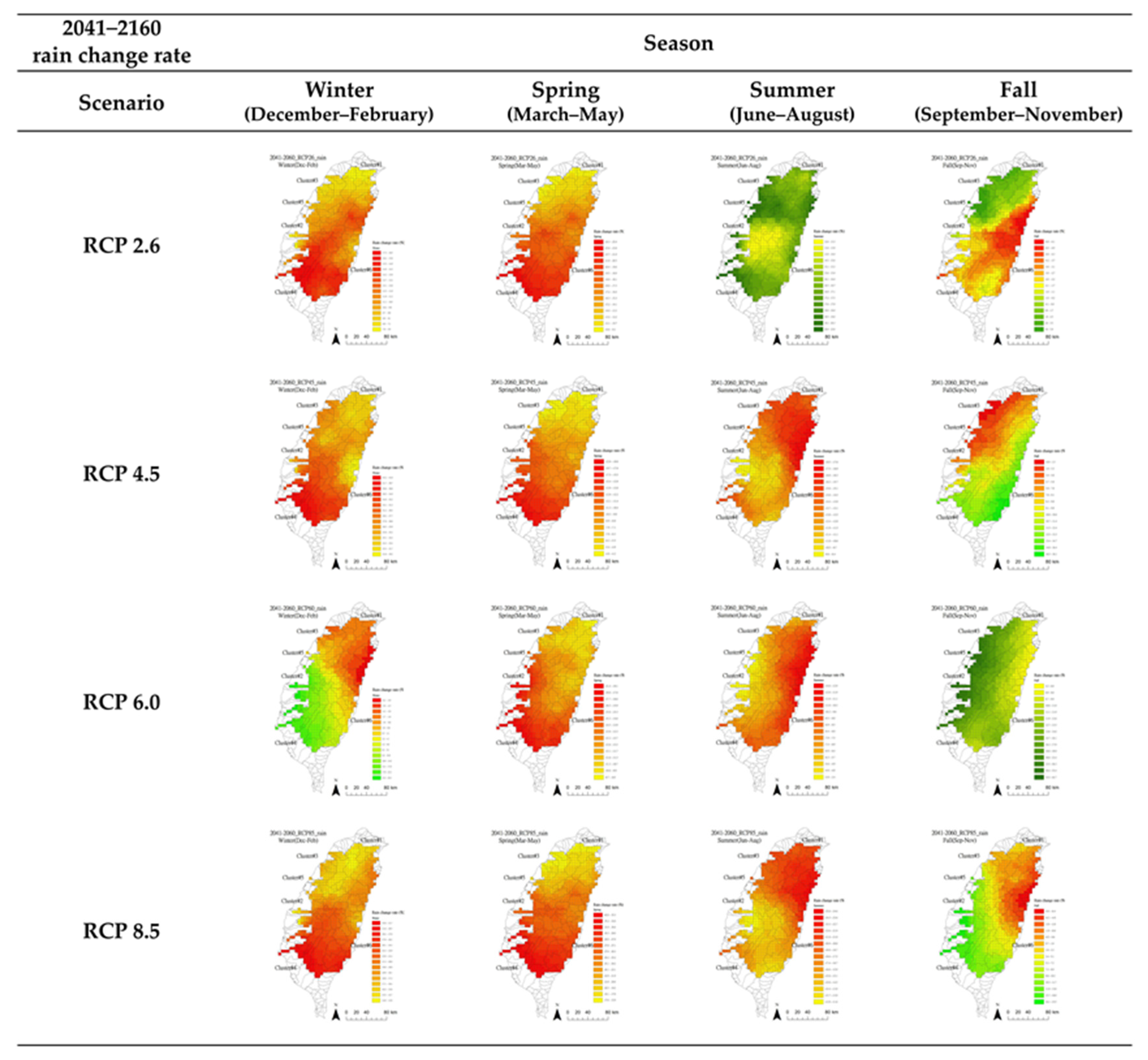
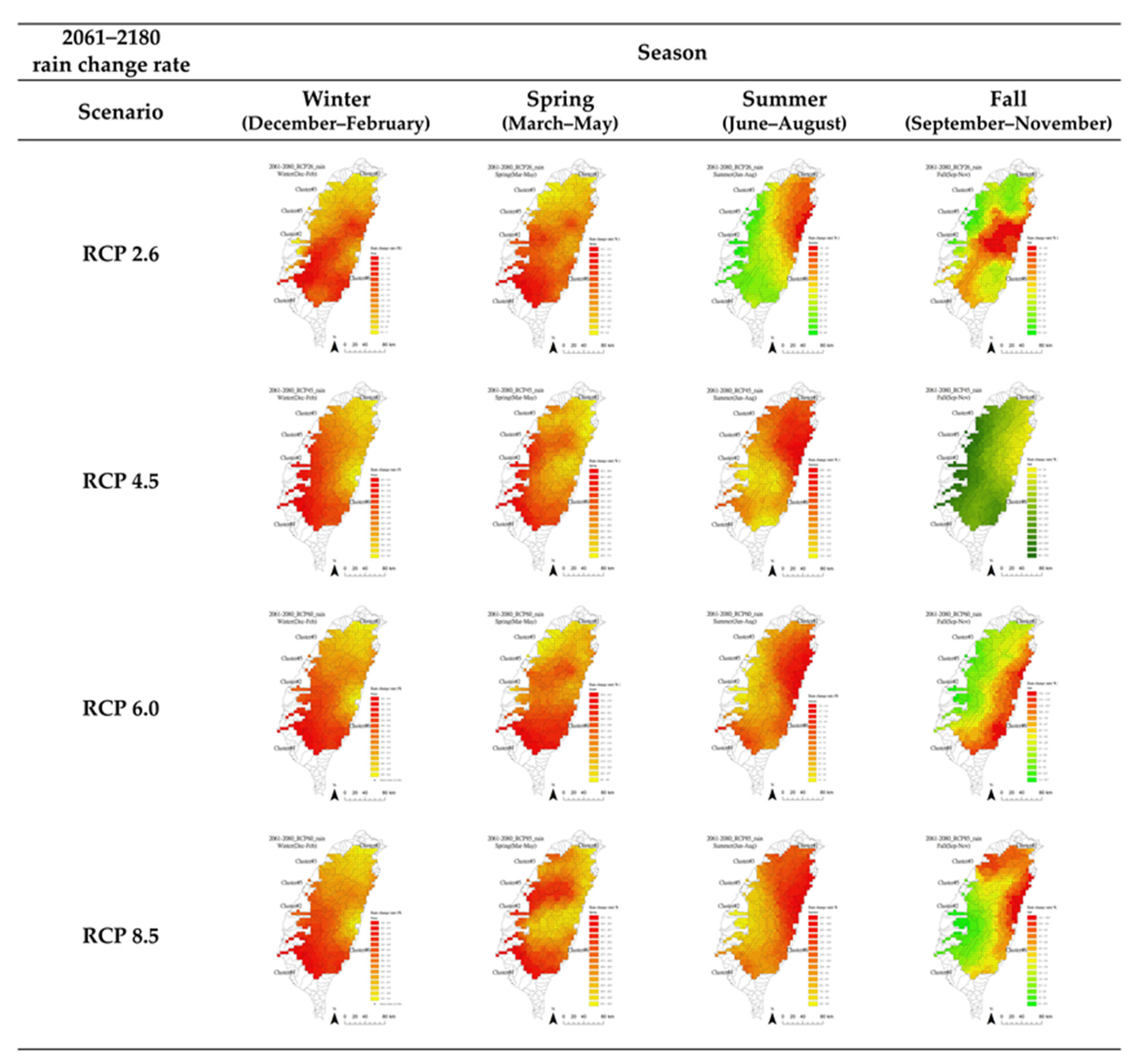
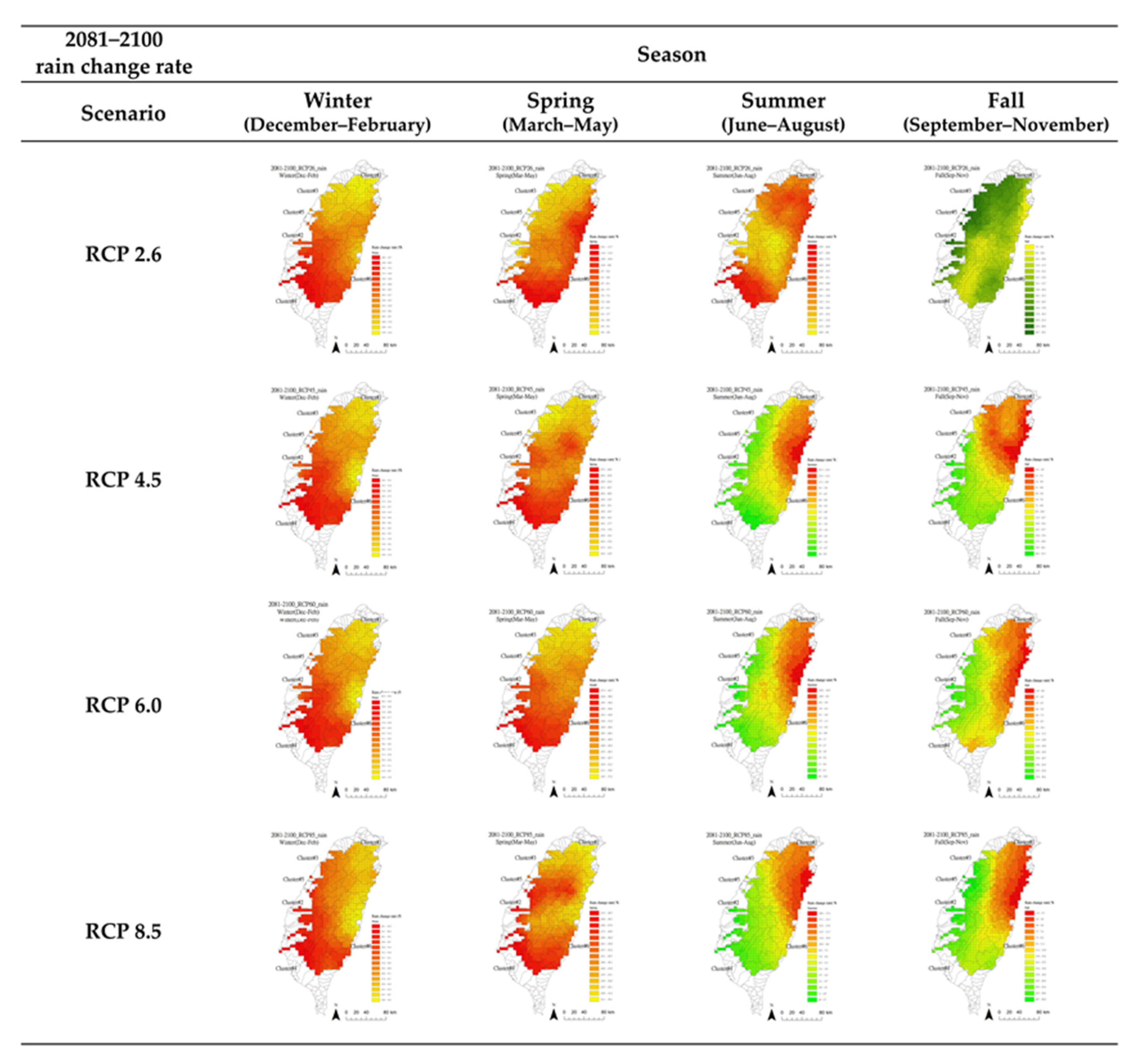
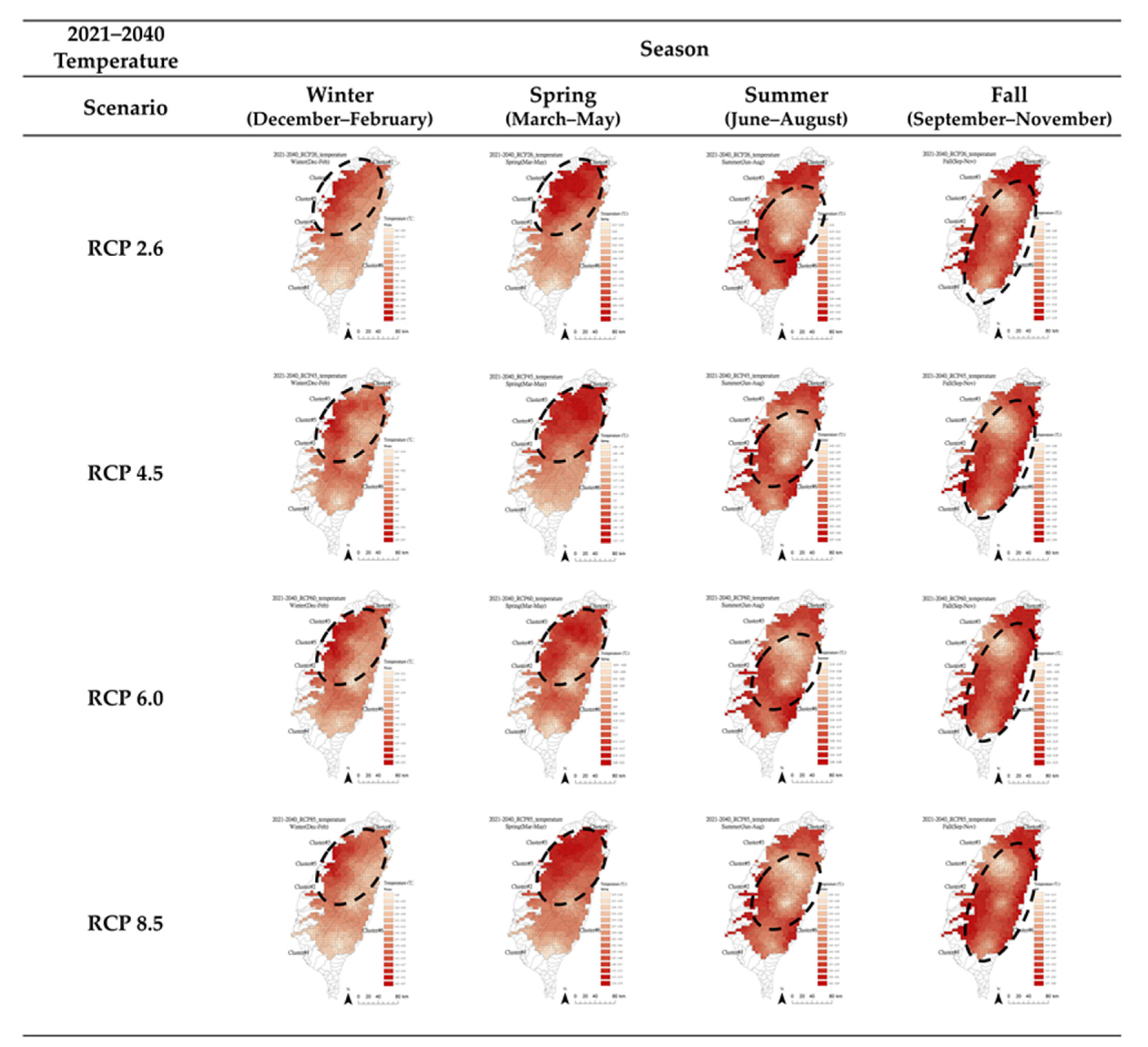
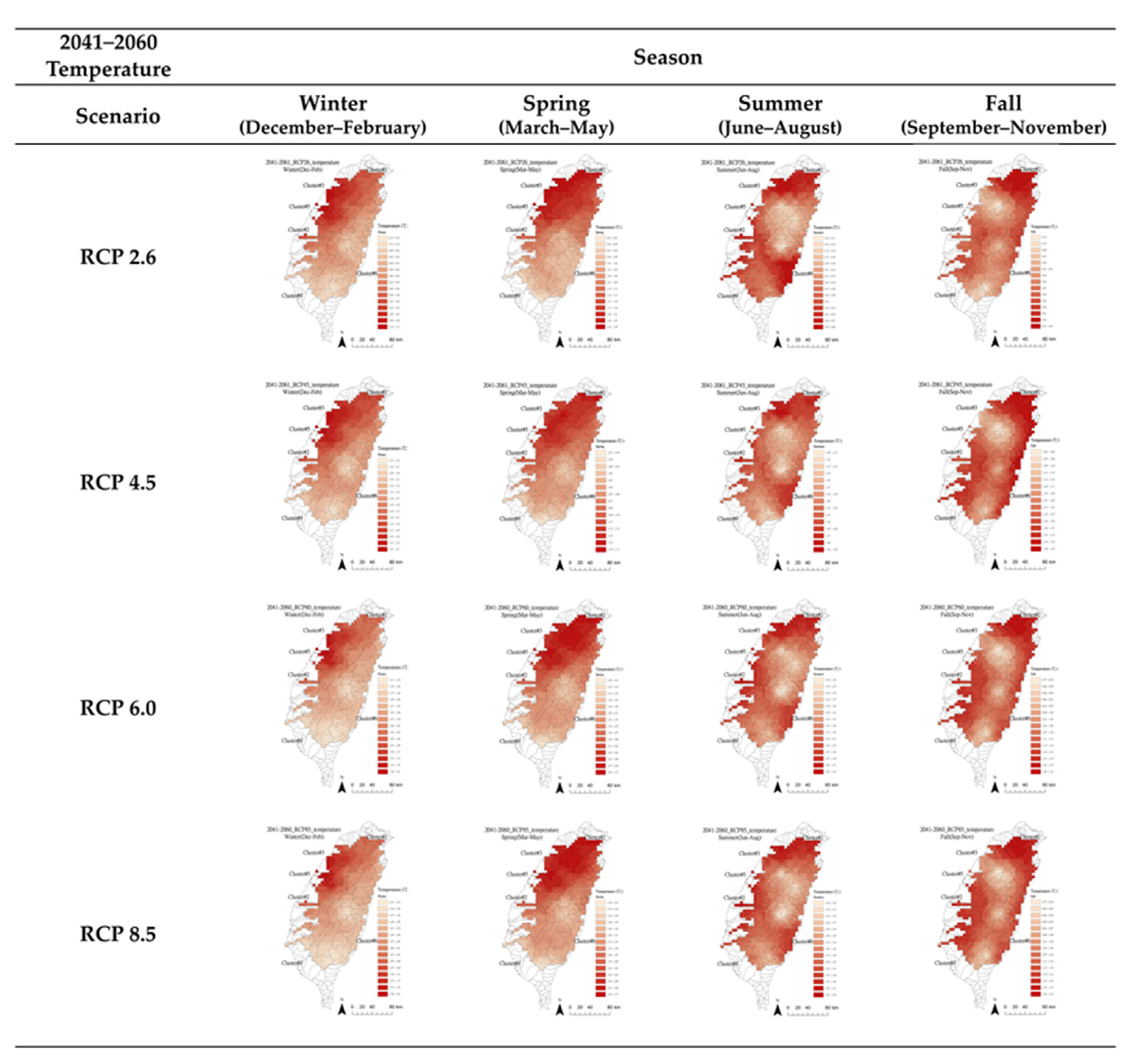
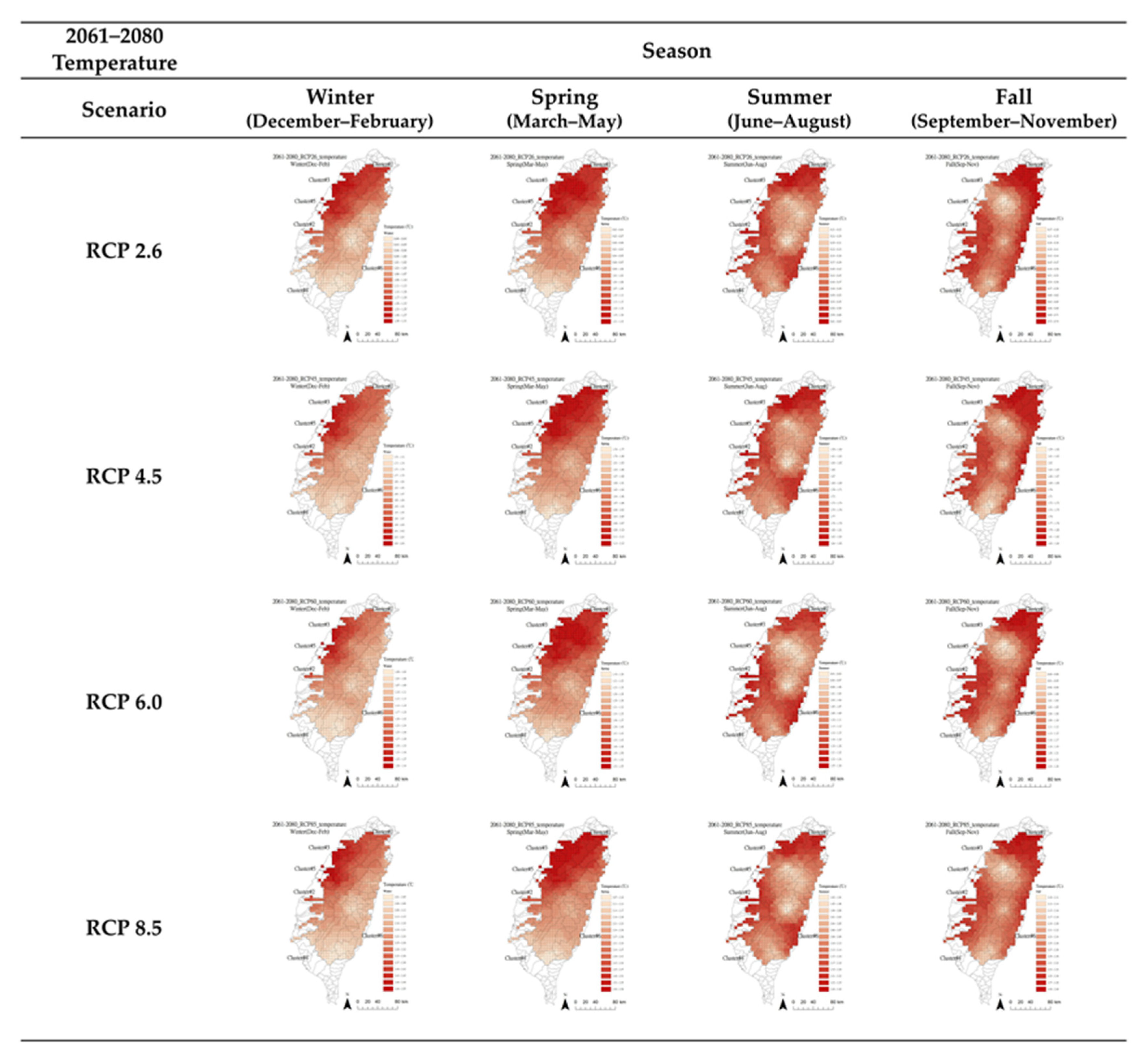
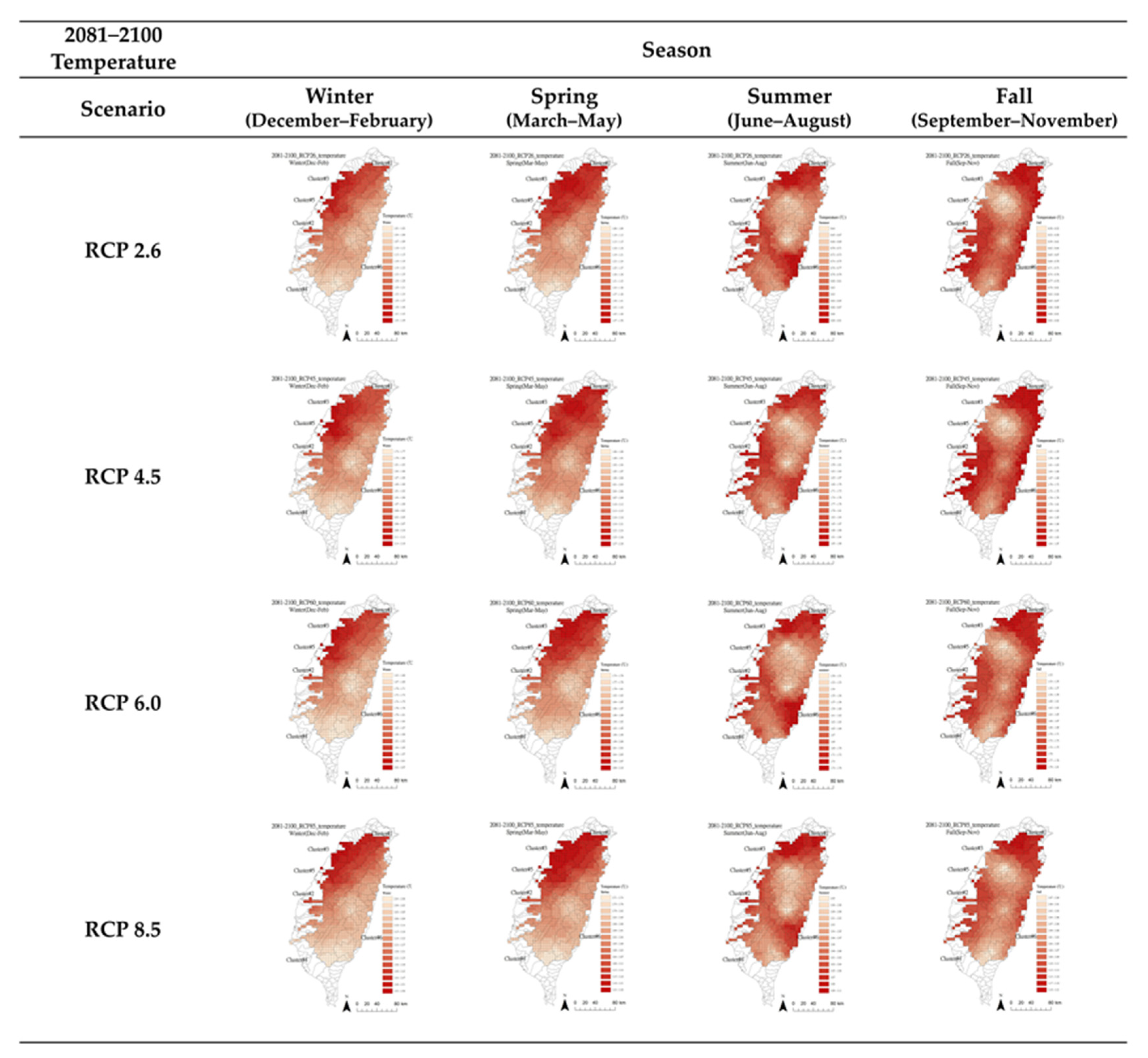

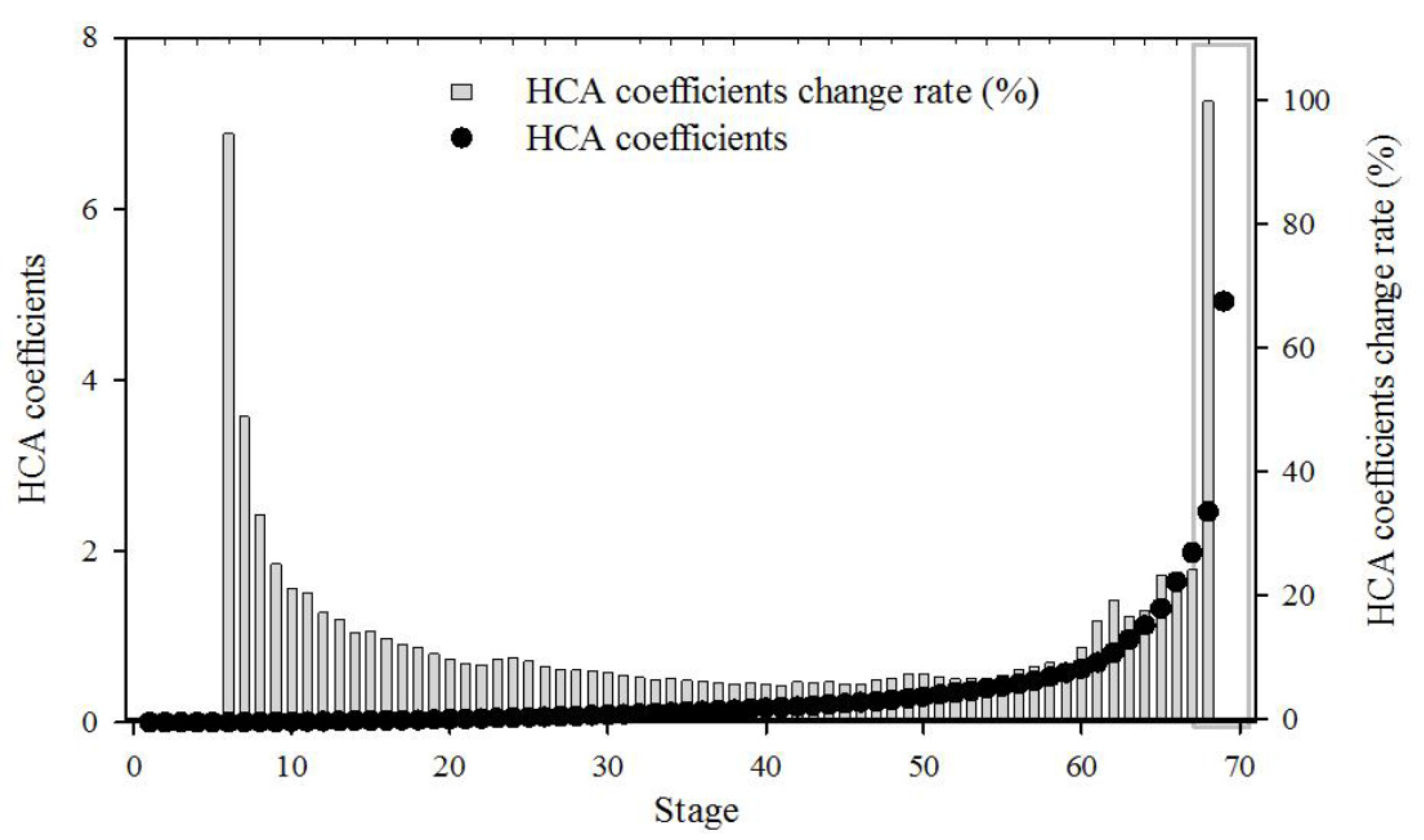
Appendix C
Correlation between NDVI and Explanatory Factors

References
- Li, C.; Wang, L.; Wang, W.; Qi, J.; Yang, L.; Zhang, Y.; Wu, L.; Cui, X.; Wang, P. An analytical approach to separate climate and human contributions to basin streamflow variability. J. Hydrol. 2018, 559, 30–42. [Google Scholar] [CrossRef]
- Nepal, S.; Flügel, W.-A.; Shrestha, A.B. Upstream-downstream linkages of hydrological processes in the Himalayan region. Ecol. Process. 2014, 3, 1–16. [Google Scholar] [CrossRef] [Green Version]
- Gomi, T.; Roy, C.S.; Richardson, J.S. Understanding processes and downstream linkages of headwater systems: Headwaters differ from downstream reaches by their close coupling to hillslope processes, more temporal and spatial variation, and their need for different means of protection from land use. BioScience 2002, 52, 905–916. [Google Scholar] [CrossRef] [Green Version]
- Fazel, N.; Haghighi, A.T.; Kløve, B. Analysis of land use and climate change impacts by comparing river flow records for headwaters and lowland reaches. Glob. Planet. Chang. 2017, 158, 47–56. [Google Scholar] [CrossRef] [Green Version]
- Liang, S.; Wang, W.; Zhang, D.; Li, Y. Quantifying the Impacts of Climate Change and Human Activities on Runoff Variation: Case Study of the Upstream of Minjiang River, China. J. Hydrol. Eng. 2020, 25, 05020025. [Google Scholar] [CrossRef]
- Huang, S.; Zang, W.; Xu, M.; Li, X.; Xie, X.; Li, Z.; Zhu, J. Study on runoff simulation of the upstream of Minjiang River under future climate change scenarios. Nat. Hazards 2015, 75, 139–154. [Google Scholar] [CrossRef]
- Daba, M.H.; You, S. Assessment of climate change impacts on river flow regimes in the upstream of Awash Basin, Ethiopia: Based on IPCC fifth assessment report (AR5) climate change scenarios. Hydrology 2020, 7, 98. [Google Scholar] [CrossRef]
- Shi, P.; Ma, X.; Hou, Y.; Li, Q.; Zhang, Z.; Qu, S.; Chen, C.; Cai, T.; Fang, X. Effects of land-use and climate change on hydrological processes in the upstream of Huai River, China. Water Resour. Manag. 2013, 27, 1263–1278. [Google Scholar] [CrossRef]
- Nauman, S.; Zulkafli, Z.; Ghazali, A.H.B.; Yusuf, B. Impact assessment of future climate change on streamflows upstream of Khanpur Dam, Pakistan using soil and water assessment tool. Water 2019, 11, 1090. [Google Scholar] [CrossRef] [Green Version]
- Wu, C.; Huang, G.; Yu, H.; Chen, Z.; Ma, J. Impact of climate change on reservoir flood control in the upstream area of the Beijiang River Basin, South China. J. Hydrometeorol. 2014, 15, 2203–2218. [Google Scholar] [CrossRef]
- Jia, L.; Shang, H.; Hu, G.; Menenti, M. Phenological response of vegetation to upstream river flow in the Heihe Rive basin by time series analysis of MODIS data. Hydrol. Earth Syst. Sci. 2011, 15, 1047–1064. [Google Scholar] [CrossRef] [Green Version]
- Chen, S.; Liu, W.; Qin, X.; Liu, Y.; Zhang, T.; Chen, K.; Hu, F.; Ren, J.; Qin, D. Response characteristics of vegetation and soil environment to permafrost degradation in the upstream regions of the Shule River Basin. Environ. Res. Lett. 2012, 7, 045406. [Google Scholar] [CrossRef] [Green Version]
- Tian, F.; Lu, Y.H.; Fu, B.J.; Zhang, L.; Zang, C.F.; Yang, Y.H.; Qiu, G.Y. Challenge of vegetation greening on water resources sustainability: Insights from a modeling-based analysis in Northwest China. Hydrol. Process. 2017, 31, 1469–1478. [Google Scholar] [CrossRef]
- Pokhrel, P.; Ohgushi, K.; Fujita, M. Impacts of future climate variability on hydrological processes in the upstream catchment of Kase River basin, Japan. Appl. Water Sci. 2019, 9, 18. [Google Scholar] [CrossRef] [Green Version]
- Xiao, H.; Huang, J.; Ma, Q.; Wan, J.; Li, L.; Peng, Q.; Rezaeimalek, S. Experimental study on the soil mixture to promote vegetation for slope protection and landslide prevention. Landslides 2017, 14, 287–297. [Google Scholar] [CrossRef]
- Guerra, C.A.; Maes, J.; Geijzendorffer, I.; Metzger, M.J. An assessment of soil erosion prevention by vegetation in Mediterranean Europe: Current trends of ecosystem service provision. Ecol. Indic. 2016, 60, 213–222. [Google Scholar] [CrossRef]
- Bronstert, A.; Niehoff, D.; Bürger, G. Effects of climate and land-use change on storm runoff generation: Present knowledge and modelling capabilities. Hydrol. Process. 2002, 16, 509–529. [Google Scholar] [CrossRef]
- Piao, S.; Fang, J.; Zhou, L.; Guo, Q.; Henderson, M.; Ji, W.; Li, Y.; Tao, S. Interannual variations of monthly and seasonal normalized difference vegetation index (NDVI) in China from 1982 to 1999. J. Geophys. Res. Atmos. 2003, 108. [Google Scholar] [CrossRef]
- Kuo, Y.-C.; Lee, M.-A.; Lu, M.-M. Association of Taiwan’s rainfall patterns with large-scale oceanic and atmospheric phenomena. Adv. Meteorol. 2016, 2016. [Google Scholar] [CrossRef] [Green Version]
- Tseng, C.-W.; Song, C.-E.; Wang, S.-F.; Chen, Y.-C.; Tu, J.-Y.; Yang, C.-J.; Chuang, C.-W. Application of High-Resolution Radar Rain Data to the Predictive Analysis of Landslide Susceptibility under Climate Change in the Laonong Watershed, Taiwan. Remote Sens. 2020, 12, 3855. [Google Scholar] [CrossRef]
- Yeh, H.F. Spatiotemporal Variation of the Meteorological and Groundwater Droughts in Central Taiwan. Front. Water 2021, 3, 1–14. [Google Scholar] [CrossRef]
- Hung, C.W.; Shih, M.F. Analysis of Severe Droughts in Taiwan and its Related Atmospheric and Oceanic Environments. Atmosphere 2019, 10, 159. [Google Scholar] [CrossRef] [Green Version]
- Lin, Y.C.; Kuo, E.D.; Chi, W.J. Analysis of Meteorological Drought Resilience and Risk Assessment of Groundwater Using Signal Analysis Method. Water Resour. Manag. 2021, 35, 179–197. [Google Scholar] [CrossRef]
- Hung, C.W.; Shih, M.F.; Lin, T.Y. The Climatological Analysis of Typhoon Tracks, Steering Flow, and the Pacific Subtropical High in the Vicinity of Taiwan and the Western North Pacific. Atmosphere 2020, 11, 543. [Google Scholar] [CrossRef]
- Chen, C.W.; Tung, Y.S.; Liou, J.J.; Li, H.C.; Cheng, C.T.; Chen, Y.M.; Oguchi, T. Assessing landslide characteristics in a changing climate in northern Taiwan. Catena 2019, 175, 263–277. [Google Scholar] [CrossRef]
- Wu, C. Landslide Susceptibility Based on Extreme Rainfall-Induced Landslide Inventories and the Following Landslide Evolution. Water 2019, 11, 2609. [Google Scholar] [CrossRef] [Green Version]
- Lin, M.-L.; Lin, S.-C.; Lin, Y.-C. Review of landslide occurrence and climate change in Taiwan. In Slope Safety Preparedness for Impact of Climate Change; CRC Press: Boca Raton, FL, USA, 2017; pp. 409–436. [Google Scholar]
- Chen, C.-N.; Tfwala, S.S.; Tsai, C.-H. Climate Change Impacts on Soil Erosion and Sediment Yield in a Watershed. Water 2020, 12, 2247. [Google Scholar] [CrossRef]
- Wu, C.-H.; Chen, S.-C.; Chou, H.-T. Geomorphologic characteristics of catastrophic landslides during typhoon Morakot in the Kaoping Watershed, Taiwan. Eng. Geol. 2011, 123, 13–21. [Google Scholar] [CrossRef]
- Lin, Y.-J.; Chang, Y.-H.; Lee, H.-Y.; Chiu, Y.-J. National policy of watershed management and flood mitigation after the 921 Chi-Chi earthquake in Taiwan. Nat. Hazards 2011, 56, 709–731. [Google Scholar] [CrossRef]
- Chiang, S.-H.; Chang, K.-T. The potential impact of climate change on typhoon-triggered landslides in Taiwan, 2010–2099. Geomorphology 2011, 133, 143–151. [Google Scholar] [CrossRef]
- Shou, K.-J.; Yang, C.-M. Predictive analysis of landslide susceptibility under climate change conditions—A study on the Chingshui River Watershed of Taiwan. Eng. Geol. 2015, 192, 46–62. [Google Scholar] [CrossRef]
- Wu, T.; Li, H.-C.; Wei, S.-P.; Chen, W.-B.; Chen, Y.-M.; Su, Y.-F.; Liu, J.-J.; Shih, H.-J. A comprehensive disaster impact assessment of extreme rainfall events under climate change: A case study in Zheng-wen river basin, Taiwan. Environ. Earth Sci. 2016, 75, 597. [Google Scholar] [CrossRef]
- Wei, S.-C.; Li, H.-C.; Shih, H.-J.; Liu, K.-F. Potential impact of climate change and extreme events on slope land hazard–a case study of Xindian watershed in Taiwan. Nat. Hazards Earth Syst. Sci. 2018, 18, 3283–3296. [Google Scholar] [CrossRef] [Green Version]
- Shou, K.-J.; Wu, C.-C.; Lin, J.-F. Predictive analysis of landslide susceptibility under climate change conditions—A study on the Ai-Liao watershed in Southern Taiwan. J. Geoengin. 2018, 13, 13–27. [Google Scholar]
- Su, Q. Long-term flood risk assessment of watersheds under climate change based on the game cross-efficiency DEA. Nat. Hazards 2020, 104, 2213–2237. [Google Scholar] [CrossRef]
- Mallick, J.; AlMesfer, M.K.; Singh, V.P.; Falqi, I.I.; Singh, C.K.; Alsubih, M.; Kahla, N.B. Evaluating the NDVI–Rainfall Relationship in Bisha Watershed, Saudi Arabia Using Non-Stationary Modeling Technique. Atmosphere 2021, 12, 593. [Google Scholar] [CrossRef]
- Chu, H.; Venevsky, S.; Wu, C.; Wang, M. NDVI-based vegetation dynamics and its response to climate changes at Amur-Heilongjiang River Basin from 1982 to 2015. Sci. Total Environ. 2019, 650, 2051–2062. [Google Scholar] [CrossRef] [PubMed]
- Chang, C.T.; Wang, S.F.; Vadeboncoeur, M.; Lin, T.C. Relating vegetation dynamics to temperature and precipitation at monthly and annual timescales in Taiwan using MODIS vegetation indices. Int. J. Remote Sens. 2014, 35, 598–620. [Google Scholar] [CrossRef]
- Tsai, H.P.; Yang, M.D. Relating vegetation dynamics to climate variables in Taiwan using 1982–2012 NDVI3g data. IEEE J. Sel. Top. Appl. Earth Obs. Remote Sens. 2016, 9, 1624–1639. [Google Scholar] [CrossRef]
- Ichii, K.; Kawabata, A.; Yamaguchi, Y. Global correlation analysis for NDVI and climatic variables and NDVI trends: 1982–1990. Int. J. Remote Sens. 2002, 23, 3873–3878. [Google Scholar] [CrossRef]
- Tsai, H.P.; Lin, Y.; Yang, M. Exploring Long Term Spatial Vegetation Trends in Taiwan from AVHRR NDVI3g Dataset using RDA and HCA Analyses. Remote Sens. 2016, 8, 290. [Google Scholar] [CrossRef] [Green Version]
- Shou, K.J.; Chen, J. On the rainfall induced deep-seated and shallow landslide hazard in Taiwan. Eng. Geol. 2021, 288, 106156. [Google Scholar] [CrossRef]
- Yang, M.D.; Chen, S.C.; Tsai, H.P. A long-term vegetation recovery estimation for Mt. Jou-Jou using multi-date SPOT 1, 2, and 4 images. Remote Sens. 2017, 9, 893. [Google Scholar] [CrossRef] [Green Version]
- Yang, M.D.; Tsai, H.P. Post-earthquake spatio-temporal landslide analysis of Huisun Experimental Forest Station. Terr. Atmos. Ocean. Sci. 2019, 30, 493–508. [Google Scholar] [CrossRef] [Green Version]
- Zeng, F.; Collatz, G.J.; Pinzon, J.E.; Ivanoff, A. Evaluating and quantifying the climate-driven interannual variability in global inventory modeling and mapping studies (GIMMS) normalized difference vegetation index (NDVI3g) at global scales. Remote Sens. 2013, 5, 3918–3950. [Google Scholar] [CrossRef] [Green Version]
- Vermote, E.; Kaufman, Y. Absolute calibration of AVHRR visible and near-infrared channels using ocean and cloud views. Int. J. Remote Sens. 1995, 16, 2317–2340. [Google Scholar] [CrossRef]
- Pinzon, J.; Brown, M.E.; Tucker, C.J. EMD correction of orbital drift artifacts in satellite data stream. In Hilbert-Huang Transform and Its Applications; World Scientific: Singapore, 2005; pp. 167–186. [Google Scholar] [CrossRef]
- Pinzon, J.E.; Tucker, C.J. A non-stationary 1981–2012 AVHRR NDVI3g time series. Remote Sens. 2014, 6, 6929–6960. [Google Scholar] [CrossRef] [Green Version]
- Holben, B.N. Characteristics of maximum-value composite images from temporal AVHRR data. Int. J. Remote Sens. 1986, 7, 1417–1434. [Google Scholar] [CrossRef]
- Bi, J.; Xu, L.; Samanta, A.; Zhu, Z.; Myneni, R. Divergent arcticboreal vegetation changes between North America and Eurasia over the past 30 years. Remote Sens. 2013, 5, 2093–2112. [Google Scholar] [CrossRef] [Green Version]
- Watson, D.F. Contouring: A Guide to the Analysis and Display of Spatial Data; Pergamon Press: New York, NY, USA, 1992. [Google Scholar]
- Taiwan Climate Change Projection Information and Adaption Knowledge Platform. Available online: https://tccip.ncdr.nat.gov.tw/ds_02_03.aspx (accessed on 30 April 2021).
- Van Vuuren, D.P.; Edmonds, J.; Kainuma, M.; Riahi, K.; Thomson, A.; Hibbard, K.; Hurtt, G.C.; Kram, T.; Lamarque, J.-F.; Masui, T.; et al. The representative concentration pathways: An overview. Clim. Chang. 2011, 109, 5–31. [Google Scholar] [CrossRef]
- Lin, C.; Tung, C. Procedure for Selecting GCM Datasets for Climate Risk Assessment. Terr. Atmos. Ocean. Sci. 2017, 28, 43–55. [Google Scholar] [CrossRef] [Green Version]
- Gauch, H.G., Jr.; Whittaker, R.H. Hierarchical classification of community data. J. Ecol. 1981, 69, 537–557. [Google Scholar] [CrossRef]
- Huang, W.; Chen, W.; Chuang, Y.; Lin, Y.; Chen, H. Biological toxicity of groundwater in a seashore area: Causal analysis and its spatial pollutant pattern. Chemosphere 2014, 100, 8–15. [Google Scholar] [CrossRef]
- Ward, J.H., Jr. Hierarchical grouping to optimize an objective function. J. Am. Stat. Assoc. 1963, 58, 236–244. [Google Scholar] [CrossRef]
- Punj, G.; Stewart, D.W. Cluster analysis in marketing research: Review and suggestions for application. J. Market. Res. 1983, 20, 134–148. [Google Scholar] [CrossRef]
- Fraley, C.; Raftery, A.E. How many clusters? Which clustering method? Answers via model-based cluster analysis. Comput. J. 1998, 41, 578–588. [Google Scholar] [CrossRef]
- Yim, O.; Ramdeen, K.T. Hierarchical cluster analysis: Comparison of three linkage measures and application to psychological data. Quant. Methods Psychol. 2015, 11, 8–24. [Google Scholar] [CrossRef]
- Rao, C.R. The use and interpretation of principal component analysis in applied research. Sankhya Ser. A 1964, 26, 329–358. [Google Scholar]
- Van den Wollenberg, A.L. Redundancy analysis an alternative for canonical correlation analysis. Psychometrika 1977, 42, 207–219. [Google Scholar] [CrossRef]
- Gittins, R. Canonical Analysis; Springer: Heidelberg, Germany, 1985. [Google Scholar]
- Legendre, P.; Legendre, L.F. Numerical Ecology; Elsevier: Amsterdam, The Netherlands, 2012. [Google Scholar]
- Buttigieg, P.L.; Ramette, A. A guide to statistical analysis in microbial ecology: A community-focused, living review of multivariate data analyses. FEMS Microbiol. Ecol. 2014, 90, 543–550. [Google Scholar] [CrossRef] [Green Version]
- Ter Braak, C.J.; Smilauer, P. CANOCO Reference Manual and CanoDraw for Windows User’s Guide: Software for Canonical Community Ordination (Version 4.5); Biometris: Wageningen, The Netherlands, 2002. [Google Scholar]
- Šmilauer, P.; Lepš, J. Multivariate Analysis of Ecological Data Using CANOCO 5; Cambridge University Press: Cambridge, UK, 2014. [Google Scholar]
- Hsu, H.H.; Chen, C.T.; Lu, M.M.; Chen, Y.M.; Chou, C.; Wu, Y.C. Scientific Report of Taiwan’s Climate Change; National Science Concil: Taipei, Taiwan, 2011. (In Chinese)
- Xu, L.; Myneni, R.B.; Chapin, F.S., III; Callaghan, T.V.; Pinzon, J.E.; Tucker, C.J.; Zhu, Z.; Bi, J.; Ciais, P.; Tommervik, H.; et al. Temperature and vegetation seasonality diminishment over northern lands. Nat. Clim. Chang. 2013, 3, 581–586. [Google Scholar] [CrossRef] [Green Version]
- Bhatt, U.S.; Walker, D.A.; Raynolds, M.K.; Bieniek, P.A.; Epstein, H.E.; Comiso, J.C.; Pinzon, J.E.; Tucker, C.J.; Steele, M.; Ermold, W. Changing seasonality of panarctic tundra vegetation in relationship to climatic variables. Environ. Res. Lett. 2017, 12, 055003. [Google Scholar] [CrossRef]
- Hsu, H.-H.; Chen, C.-T. Observed and projected climate change in Taiwan. Meteorol. Atmos. Phys. 2002, 79, 87–104. [Google Scholar] [CrossRef]
- Lin, C.-Y.; Chien, Y.-Y.; Su, C.-J.; Kueh, M.-T.; Lung, S.-C. Climate variability of heat wave and projection of warming scenario in Taiwan. Clim. Chang. 2017, 145, 305–320. [Google Scholar] [CrossRef] [Green Version]
- Chen, Y.-M.; Chen, C.-W.; Chao, Y.-C.; Tung, Y.-S.; Liou, J.-J.; Li, H.-C.; Cheng, C.-T. Future Landslide characteristic assessment using ensemble climate change scenarios: A case study in Taiwan. Water 2020, 12, 564. [Google Scholar] [CrossRef] [Green Version]
- Hung, C.-W.; Kao, P.-K. Weakening of the winter monsoon and abrupt increase of winter rainfalls over northern Taiwan and southern China in the early 1980s. J. Clim. 2010, 23, 2357–2367. [Google Scholar] [CrossRef]
- Kao, S.-J.; Huang, J.-C.; Lee, T.-Y.; Liu, C.; Walling, D. The changing rainfall–runoff dynamics and sediment response of small mountainous rivers in Taiwan under a warming climate. In Sediment Problems and Sediment Management in Asian River Basins (IAHS Publ 349); IAHS Press: Wallingford, UK, 2011; Available online: https://www.researchgate.net/profile/Shuh-Ji-Kao-2/publication/286136294_The_changing_rainfall-runoff_dynamics_and_sediment_response_of_small_mountainous_rivers_in_Taiwan_under_a_warming_climate/links/5780ee6008ae01f736e6b1c0/The-changing-rainfall-runoff-dynamics-and-sediment-response-of-small-mountainous-rivers-in-Taiwan-under-a-warming-climate.pdf (accessed on 1 May 2021).
- Strauch, A.M.; MacKenzie, R.A.; Giardina, C.P.; Bruland, G.L. Climate driven changes to rainfall and streamflow patterns in a model tropical island hydrological system. J. Hydrol. 2015, 523, 160–169. [Google Scholar] [CrossRef]
- Chiu, Y.-J.; Lee, H.-Y.; Wang, T.-L.; Yu, J.; Lin, Y.-Y.; Yuan, Y. Modeling sediment yields and stream stability due to sediment-related disaster in Shihmen Reservoir watershed in Taiwan. Water 2019, 11, 332. [Google Scholar] [CrossRef] [Green Version]
- Ramírez, A.; Gutierrez-Fonseca, P.E.; Kelly, S.P.; Engman, A.C.; Wagner, K.; Rosas, K.G.; Rodriguez, N. Drought facilitates species invasions in an urban stream: Results from a long-term study of tropical island fish assemblage structure. Front. Ecol. Evol. 2018, 6, 115. [Google Scholar] [CrossRef] [Green Version]
- Lu, M.-C.; Chang, C.-T.; Lin, T.-C.; Wang, L.-J.; Wang, C.-P.; Hsu, T.-C.; Huang, J.-C. Modeling the terrestrial N processes in a small mountain catchment through INCA-N: A case study in Taiwan. Sci. Total. Environ. 2017, 593, 319–329. [Google Scholar] [CrossRef]
- Chen, S.-C.; Chou, H.-T.; Chen, S.-T.; Wu, C.-H.; Lin, B.-S. Characteristics of rainfall-induced landslides in Miocene formations: A case study of the Shenmu watershed, Central Taiwan. Eng. Geol. 2017, 169, 133–146. [Google Scholar] [CrossRef]
- Wu, C.; Lin, C. Spatiotemporal Hotspots and Decadal Evolution of Extreme Rainfall-Induced Landslides: Case Studies in Southern Taiwan. Water 2021, 13, 2090. [Google Scholar] [CrossRef]
- Li, H.-C.; Hsiao, Y.-H.; Chang, C.-W.; Chen, Y.-M.; Lin, L.-Y. Agriculture Adaptation Options for Flood Impacts under Climate Change—A Simulation Analysis in the Dajia River Basin. Sustainability 2021, 13, 7311. [Google Scholar] [CrossRef]
- Chang, H.-S.; Su, Q. Exploring the coupling relationship of stormwater runoff distribution in watershed from the perspective of fairness. Urban Clim. 2021, 36, 100792. [Google Scholar] [CrossRef]
- Wang, Y.-H.; Chu, C.-C.; You, G.J.-Y.; Gupta, H.V. Evaluating Uncertainty in Fluvial Geomorphic Response to Dam Removal. J. Hydrol. Eng. 2020, 25, 04020022. [Google Scholar] [CrossRef]
- Peng, L.-C.; Lin, Y.-P.; Chen, G.-W.; Lien, W.-Y. Climate change impact on spatiotemporal hotspots of hydrologic ecosystem services: A case study of Chinan catchment, Taiwan. Water 2019, 11, 867. [Google Scholar] [CrossRef] [Green Version]
- Lin, J.-Y.; Chen, Y.-C.; Chang, C.-T. Costs and environmental benefits of watershed conservation and restoration in Taiwan. Ecol. Eng. 2020, 142, 105633. [Google Scholar] [CrossRef]

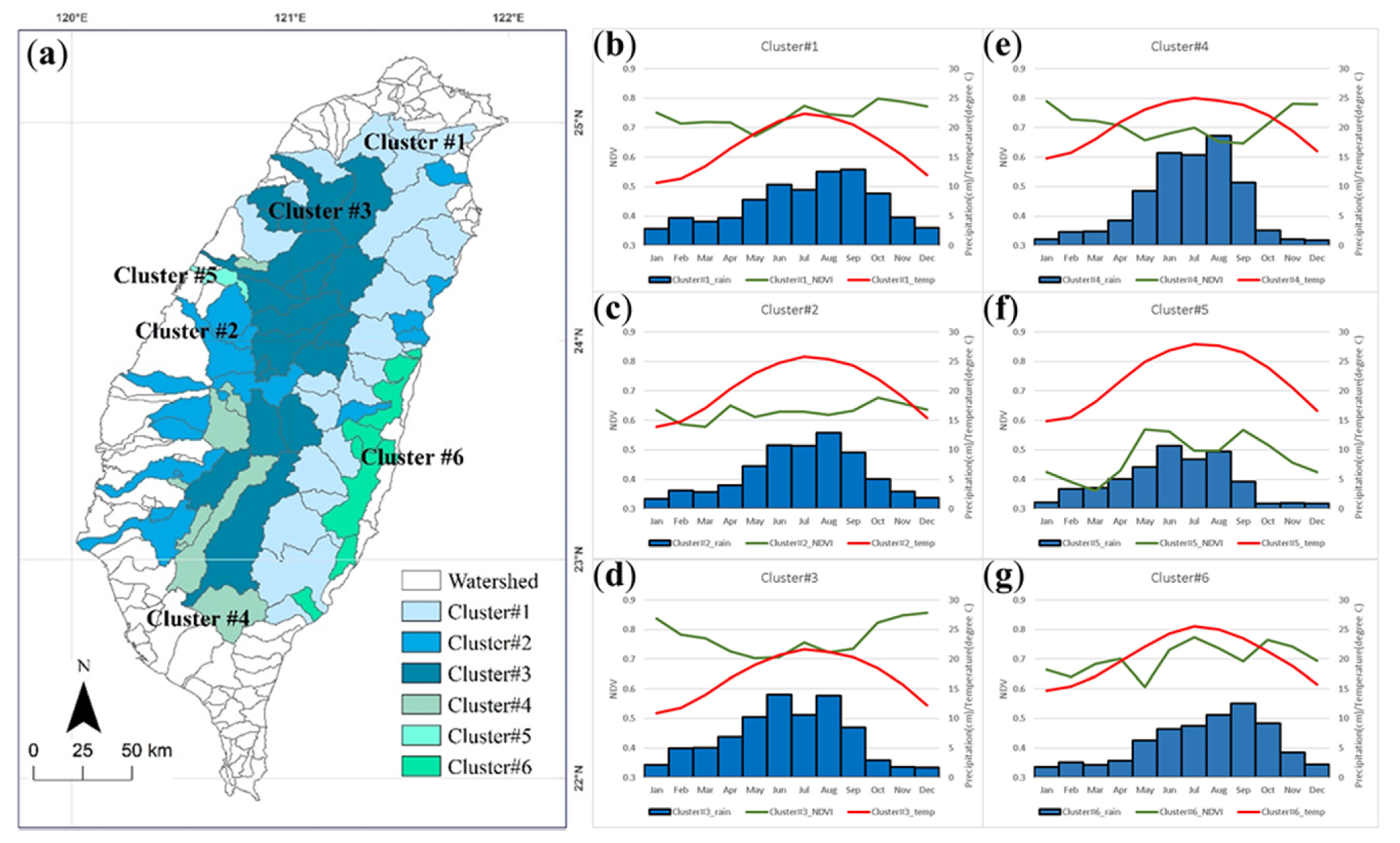
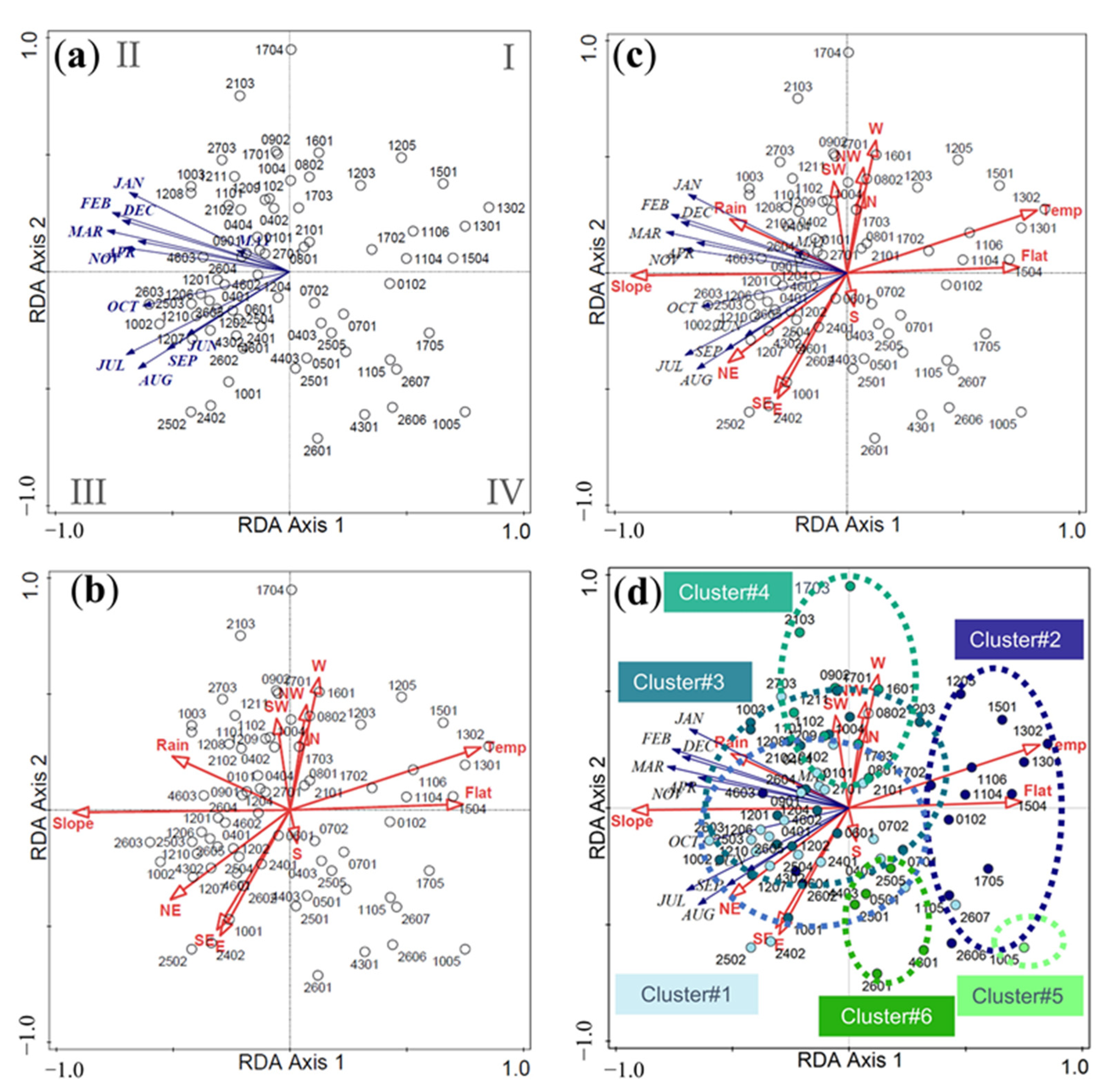
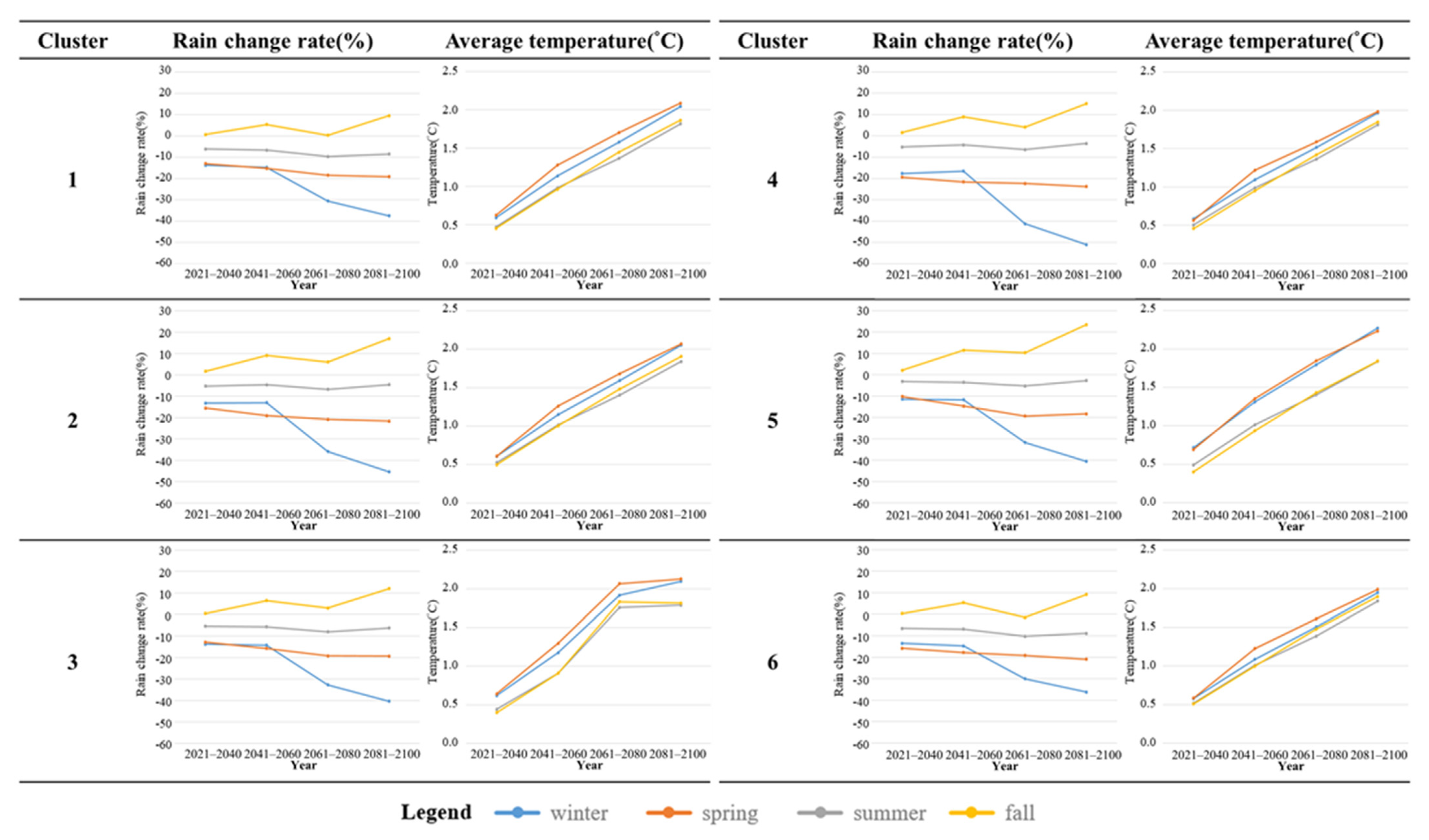
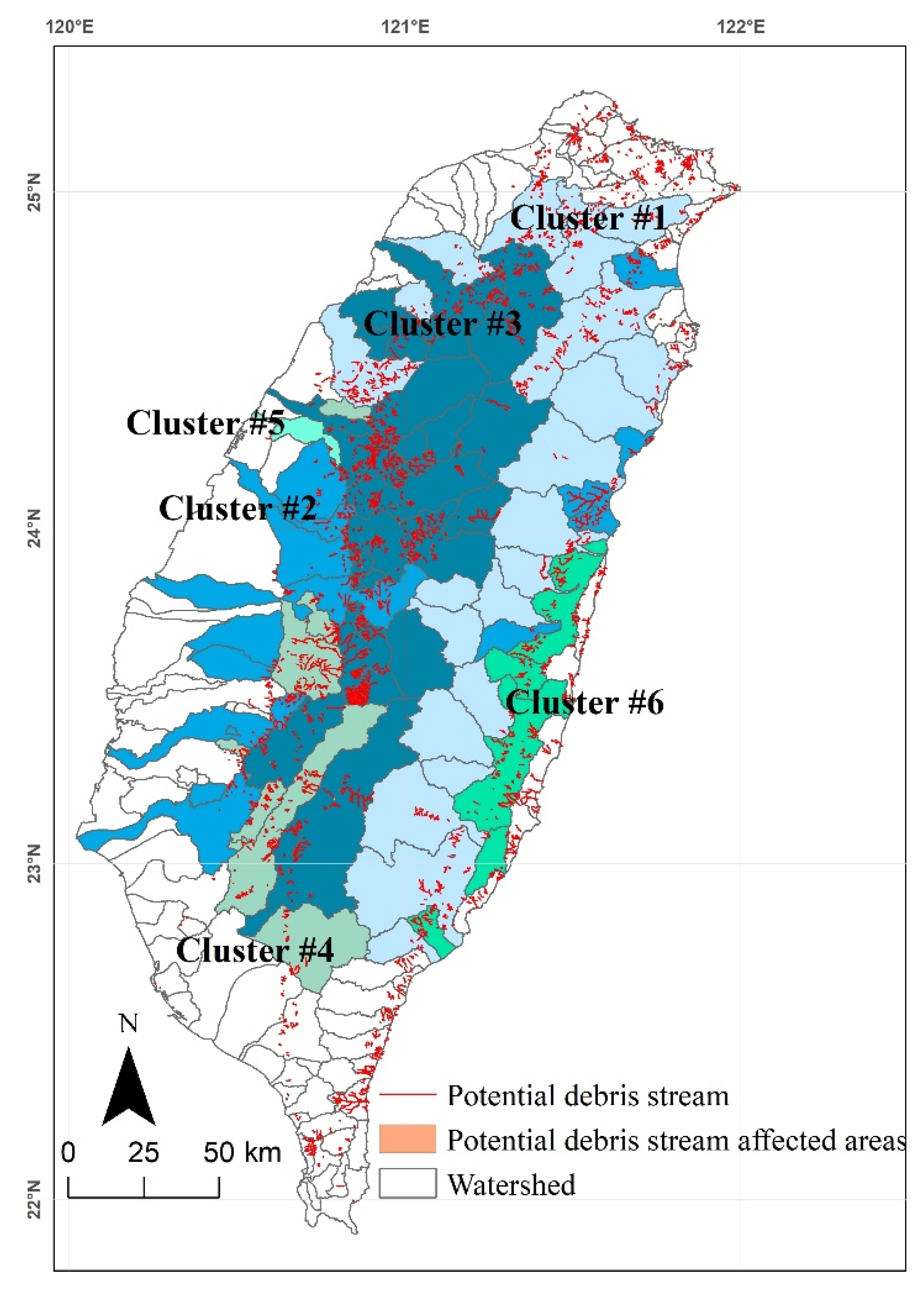
| Cluster | Number of Watersheds | Slope (Degree) | Aspect (%) | ||||||||
|---|---|---|---|---|---|---|---|---|---|---|---|
| Flat | North | North East | East | South East | South | South West | West | North West | |||
| 1 | 22 | 26.7 | 1 | 12 | 14 | 14 | 14 | 12 | 11 | 11 | 12 |
| 2 | 15 | 15.6 | 5 | 12 | 10 | 12 | 12 | 12 | 11 | 12 | 12 |
| 3 | 19 | 27.9 | 1 | 13 | 11 | 11 | 12 | 12 | 13 | 14 | 14 |
| 4 | 8 | 21.2 | 0 | 14 | 10 | 9 | 9 | 10 | 13 | 16 | 17 |
| 5 | 1 | 4.5 | 2 | 14 | 8 | 6 | 5 | 11 | 16 | 19 | 19 |
| 6 | 5 | 17.9 | 1 | 9 | 13 | 19 | 19 | 11 | 9 | 10 | 9 |
| Monthly NDVI | Axis 1 (%) | Axis 1 and 2 (%) | Total (%) |
|---|---|---|---|
| January | 46.72 | 58.22 | 58.52 |
| February | 57.39 | 63.80 | 64.51 |
| March | 60.83 | 63.97 | 66.20 |
| April | 42.00 | 43.74 | 47.60 |
| May | 5.10 | 5.96 | 35.22 |
| June | 19.31 | 26.68 | 33.46 |
| July | 48.56 | 61.10 | 63.76 |
| August | 41.80 | 58.96 | 60.19 |
| September | 27.30 | 38.39 | 45.12 |
| October | 39.20 | 41.31 | 46.42 |
| November | 49.65 | 50.72 | 52.08 |
| December | 51.05 | 55.93 | 56.70 |
| Average | 40.74 | 47.40 | 52.48 |
| Name of Variable | Explains (%) |
|---|---|
| Slope | 35.2 **** |
| Temperature | 27.8 **** |
| Flat | 17.2 **** |
| North East | 11.2 **** |
| Rain | 10.6 **** |
| East | 5.9 ** |
| South East | 5.7 ** |
| West | 5.2 ** |
| North West | 3.6 * |
| South West | 2.7 |
| North | 2.5 |
| South | 0.3 |
| Cluster | (A) Number of Sites of Potential Debris Stream Affected Area | Ratio of (A) to the Total Number of Sites | (B) Number of Potential Debris Streams | Ratio of (B) to the Total Number of Streams |
|---|---|---|---|---|
| 1 | 370 | 19.9 | 337 | 19.5 |
| 2 | 237 | 12.7 | 199 | 11.5 |
| 3 | 614 | 33.0 | 531 | 30.8 |
| 4 | 219 | 11.8 | 155 | 9.0 |
| 5 | 4 | 0.2 | 6 | 0.3 |
| 6 | 166 | 8.9 | 139 | 8.1 |
| Sum | 1610 | 86.4 | 1367 | 79.2 |
| Total number of sites/streams | 1863 | 1726 |
Publisher’s Note: MDPI stays neutral with regard to jurisdictional claims in published maps and institutional affiliations. |
© 2021 by the authors. Licensee MDPI, Basel, Switzerland. This article is an open access article distributed under the terms and conditions of the Creative Commons Attribution (CC BY) license (https://creativecommons.org/licenses/by/4.0/).
Share and Cite
Tsai, H.P.; Wong, W.-Y. Cluster and Redundancy Analyses of Taiwan Upstream Watersheds Based on Monthly 30 Years AVHRR NDVI3g Data. Atmosphere 2021, 12, 1206. https://doi.org/10.3390/atmos12091206
Tsai HP, Wong W-Y. Cluster and Redundancy Analyses of Taiwan Upstream Watersheds Based on Monthly 30 Years AVHRR NDVI3g Data. Atmosphere. 2021; 12(9):1206. https://doi.org/10.3390/atmos12091206
Chicago/Turabian StyleTsai, Hui Ping, and Wei-Ying Wong. 2021. "Cluster and Redundancy Analyses of Taiwan Upstream Watersheds Based on Monthly 30 Years AVHRR NDVI3g Data" Atmosphere 12, no. 9: 1206. https://doi.org/10.3390/atmos12091206
APA StyleTsai, H. P., & Wong, W.-Y. (2021). Cluster and Redundancy Analyses of Taiwan Upstream Watersheds Based on Monthly 30 Years AVHRR NDVI3g Data. Atmosphere, 12(9), 1206. https://doi.org/10.3390/atmos12091206







